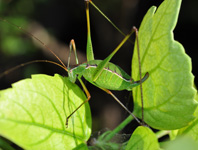Abstract
A second species, and first Central American record, of the phorid fly genus Lenkoa Borgmeier (Diptera: Phoridae).
Many species of phorid flies have wingless or brachypterous females. Mostly, they belong to a group classified within the subfamily Metopininae corresponding to the Metopina group of genera of Brown (1992a) or the tribe Metopinini of Disney (2003, not 1987). The males of this group are much more typical in appearance, with well-developed wings, larger eyes, and fully developed abdominal tergites. These males carry females during a mating flight, often dispersing them to new breeding sites (Miller 1984). Generally, the sexual dimorphism is so great that the sexes cannot be confidently associated unless they are collected in copula. This has led to a profusion of species being described as males and females in separate genera. Some of these brachypterous females, both within the Metopinini and elsewhere in other Phoridae, have been correctly associated with their males when they are found together (e.g., Brown 1986, 1992b, 1994), but many remain unassociated.
References
Borgmeier, T. (1969) New or little-known phorid flies, mainly of the Neotropical Region. Studia Entomologica, 12, 33–132.
Borkent, A. & Brown, B.V. (2015) How to inventory tropical flies (Diptera)-One of the megadiverse orders of insects. Zootaxa, 3949 (3), 301–322.
http://dx.doi.org/10.11646/zootaxa.3949.3.1Brown, B.V. (1986) Striking sexual dimorphism and its taxonomic consequences among New World phorid flies (Diptera). Proceedings of the Entomological Society of Washington, 88, 787–788.
Brown, B.V. (1992a) Generic revision of Phoridae of the Nearctic Region and phylogenetic classification of Phoridae, Sciadoceridae and Ironomyiidae (Diptera: Phoridea). Memoirs of the Entomological Society of Canada, 164, 1–144.
Brown, B.V. (1992b) Life history, immature stages and undescribed male of Rhynchomicropteron (Diptera: Phoridae). Journal of Natural History, 26, 407–416.
Brown, B.V. (1994) Another generic synonym resulting from sexually dimorphic Phoridae (Diptera): Psyllomyia Loew (1857) and Multinevra Disney (1979). Proceedings of the Entomological Society of Washington, 96, 764.
Brown, B.V., Amorim, D.S. & Kung, G.A. (2015) New morphological characters for classifying Phoridae (Diptera) from the structure of the thorax. Zoological Journal of the Linnean Society, 173, 424–485.
http://dx.doi.org/10.1111/zoj.12208Disney, R.H.L. (1987) Observations on a peculiar mechanism in the crop of some Phoridae (Diptera) and its taxonomic value. Journal of Natural History, 21, 275–280.
http://dx.doi.org/10.1080/00222938700771001Disney, R.H.L. (1994) Scuttle flies: the Phoridae. Chapman and Hall, London, 467 pp.
Disney, R.H.L. (2003) The dorsal abdominal glands and the higher classification of the Phoridae (Diptera). Zootaxa, 293, 1–16.
Miller, P.L. (1984) Alternative reproductive routines in a small fly, Puliciphora borinquenensis (Diptera: Phoridae). Ecological Entomology, 9, 293–302.
http://dx.doi.org/10.1111/j.1365-2311.1984.tb00852.x

